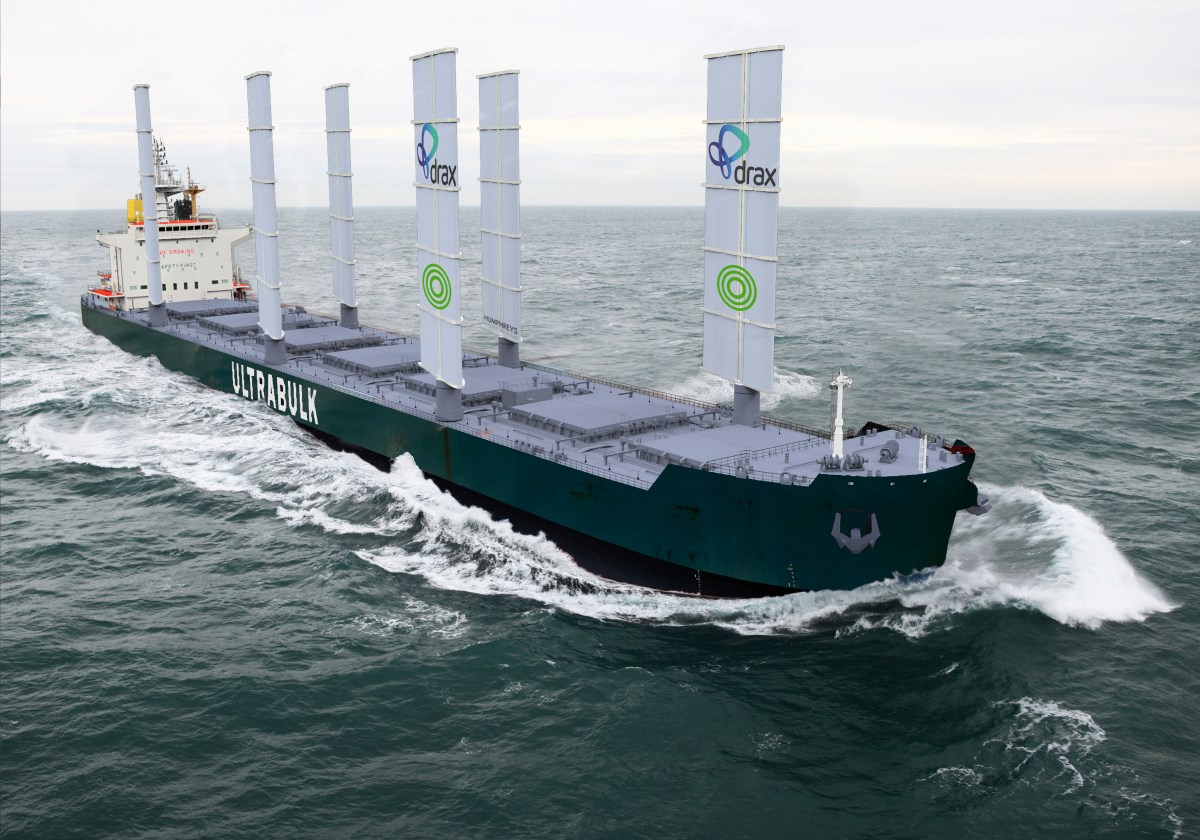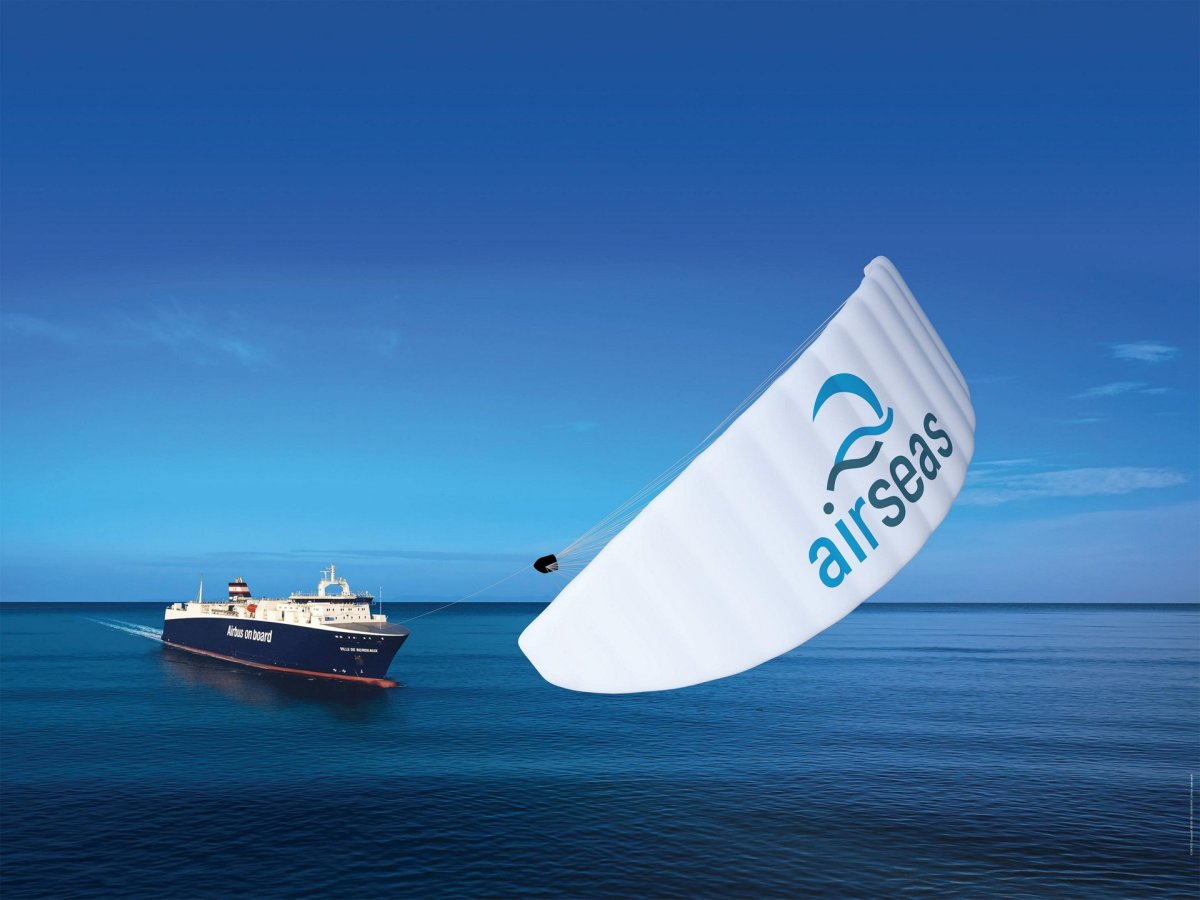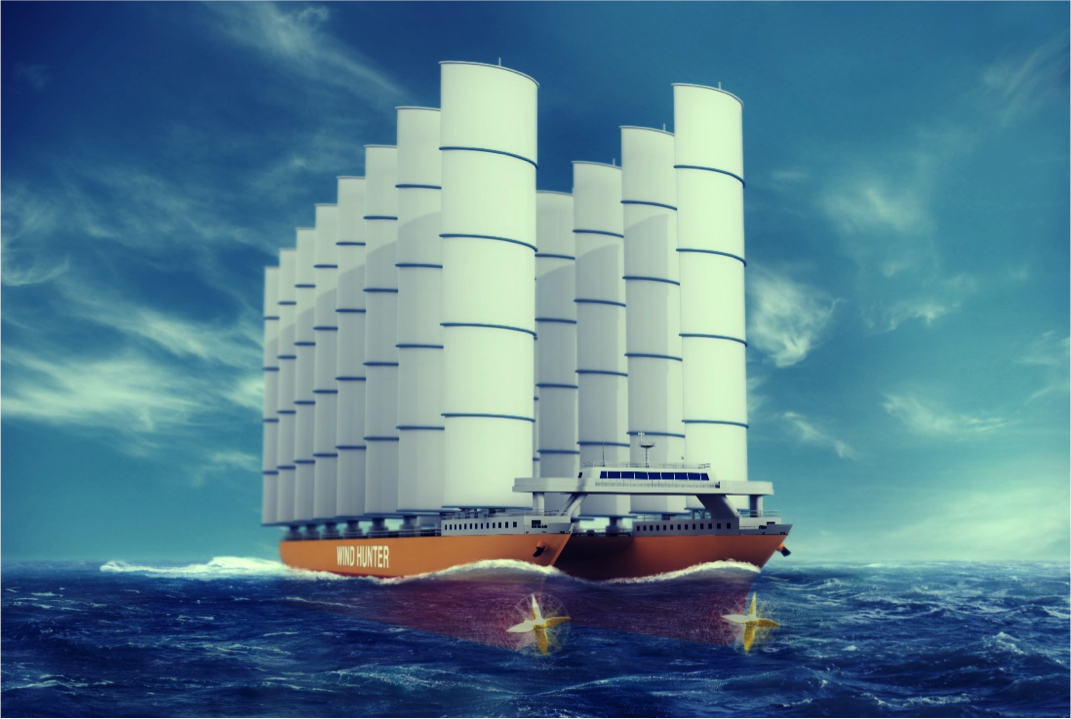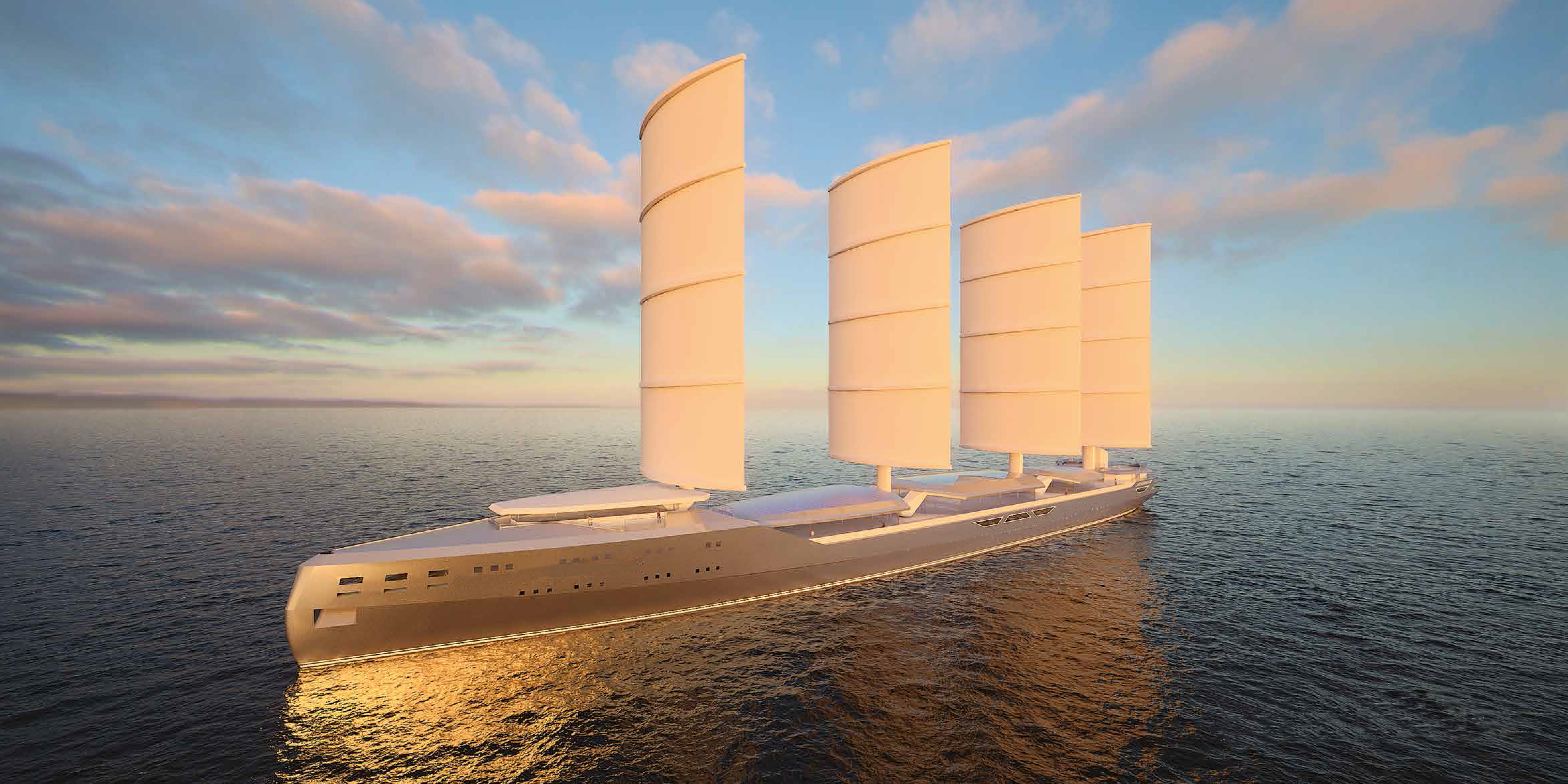An evening drizzle falls on the Dutch port city of Rotterdam as dockworkers untie the moorings of Estraden and shove the 535-foot cargo ship from the industrial dock. Captain Mikko Innanen steps into the bridge, a dark room with large windows and glowing radar screens, where voices crackling over the radio in English, Dutch, and Finnish confirm that the coast is clear. Innanen takes the helm, steering the ship from the tranquil harbor into the choppy North Sea.
The main engines roar below as Estraden begins its voyage to northern England, carrying tanks of hazardous chemicals and containers of cargo. Then Innanen pushes a button.
On the ship’s deck, two 60-foot-tall tubes twirl to life, spinning like hyperactive barber’s poles. The vertical rotor sails help propel Estraden by harnessing the wind, like modern metal versions of the age-old canvas sheet. Each rotating cylinder drags air around it, forming areas of high and low pressure and producing a forward thrust — reducing some of the demand for the diesel engines.
Up in the bridge, the change is imperceptible. The crew slowly shuffles into the room, watching the harbor lights fade into the inky black waters. The captain flips on a music station to fill the silence, and Lenny Kravitz wails.
The effects of the rotor sails may seem subtle to those aboard the ship, but the implications of technologies like this are huge. Today, more than 94,000 merchant vessels ply the world’s waterways, hauling about 90 percent of all globally traded goods. Freighters and tankers move everything from coffee and chocolate to cement, crude oil, and live cattle. All but a sliver of these ships exclusively use fossil fuels to do so. As a result, the global shipping industry accounts for roughly 3 percent of total annual greenhouse gas emissions, and that number is set to rise.
Rotor sails, which can shave 5 to 20 percent off a ship’s fuel use, are part of a larger effort to replace diesel-driven ships with vessels that use wind power, cleaner-burning fuels, hydrodynamic designs, and advanced data tools to transport our precious cargo while pumping less carbon into the atmosphere.
While clean shipping advocates have worked for decades to ditch dirty marine fuels, the movement has gained considerable momentum in recent years. After a slew of failed attempts and stalled initiatives, mounting international pressure to act on climate change has brought renewed determination.
Still, upgrading the world’s shipping fleet will be a massive, extraordinarily expensive undertaking, and industry experts say the timeline is tight. The first zero-emission cargo ships must enter commercial operations within 10 years to give enough time for the entire world fleet to make the change by 2050, as global climate objectives require.
“I don’t think there’s any argument any longer about the need to do it,” said Diane Gilpin, CEO of the Smart Green Shipping Alliance in England. “There is anxiety about which is the most appropriate way, because nobody wants to make a mistake. But you have to take a risk.”
[protected-iframe id=”ff7bb37b955a5c27e436993abfbae603-5104299-30922307″ info=”//www.shipmap.org” frameborder=”0″]
Rotor sails first graced the North Sea in the 1920s, when Anton Flettner, a German aviation engineer, installed his spinning cylinders on a cargo ship named Buckau. But early versions of the technology suffered from mechanical issues and bad timing. Diesel engines were rapidly multiplying across shipyards, just as crude oil was gushing from newly drilled wells. Flettner’s rotors failed to draw much interest.
The influx of cheap oil and powerful engines allowed the global maritime industry to dramatically expand its size and reach — and its environmental footprint. Beyond greenhouse gases, cargo ships are now significant sources of sulfur oxide and nitrogen oxide emissions, which threaten people’s health, particularly near busy shipping routes or ports. Mechanical noise from giant, swooping ship propellers disrupts the ocean soundscape, affecting marine life. Invasive species hitch rides on ships’ hulls or in ballast water tanks, disrupting ecosystems. Fuel spills are particularly risky in fragile, hard-to-reach regions like the Arctic.
And yet shipping is indispensable to our modern lives. Cargo ships move trillions of dollars’ worth of goods each year, delivering 10.7 billion metric tons in 2017 alone. That’s up 4 percent from the previous year, and quadruple the amount of cargo moved in 1970, according to United Nations trade statistics. For the industry, the challenge is to develop technologies that can somehow maintain this massive flow without wreaking the same environmental havoc.
When it comes to curbing emissions, there’s no shortage of creative proposals. In Norway, the Vindskip project envisions an entire ship that functions like a sail. The tall, thin hull would work like an airplane wing, creating aerodynamic lift that pulls the ship forward. Wind Hunter, a Japanese cargo ship design, would produce hydrogen from seawater, then run the gas through a fuel cell to propel the vessel. Shipping giant NYK has drawn a vessel with flapping, underwater foils that mimic the movement of dolphins, in lieu of typical propellers. A 97,000-square-foot array of solar panels covers the entire deck, while a honeycomb-like “bionic” hull makes for a lighter, more energy-efficient ship.
But transforming digitally rendered dreamboats into real steel ships requires navigating many obstacles. It means gathering immense resources and forging collaborations among shipping companies, authorities, and financial backers. An abundance of good timing also helps.
In Gilpin’s experience, balancing these moving parts can be tricky. Her alliance, a broad group of environmentally conscious experts, has been working to build a 100-percent renewable ship for over a decade.
In the early 2000s, the organization devised a 330-foot, zero-emission vessel that would use existing, proven technologies in novel ways. Fuels made from food waste streams would drive a gas propulsion engine, while automated sails would unfurl, retract, or rotate to capture the optimal amount of wind, in a “DynaRig”-style system that doesn’t require ropes or elbow grease.
A shipbuilder, a cargo owner, and technology providers all signed on to build the $45 million vessel, and an independent analysis validated the ship’s economic feasibility on certain routes. But outside factors conspired against them. Fallout from the 2008 global financial crisis, along with surging oil prices, left the shipping industry bleeding cash and made investors skittish. The 2009 U.N. climate talks ended without a global agreement, further eroding appetites for green-but-risky projects.
“It was like a cascade,” Gilpin said of the partnership’s unraveling.

The Smart Green Shipping Alliance hopes to launch this retrofitted bulk carrier by 2021. Smart Green Shipping Alliance
When Gilpin and I first met in person, in November 2017, it was aboard an elegant river cruise ship in Germany. Gilpin, who has close-cropped hair and thick-rimmed glasses, organized a maritime summit to coincide with the U.N. climate conference in Bonn. More than a hundred shipping executives, policy experts, and environmentalists gathered on the Rhine River that day to discuss how the sector could play its part in limiting global warming. The 2015 Paris Climate Agreement excluded emissions from international shipping and aviation in its targets, leaving those industries to regulate themselves.
During panels and over half-pints of Kölsch, many conversations focused on steps that companies can take today — operating ships at slower speeds, digitizing supply chains, financing energy-efficient retrofits — to immediately reduce carbon emissions. But overarching questions about how to decarbonize cargo ships, and who should take the lead, found no easy answers. Owners of small shipping fleets voiced concerns that the transition would force them to fold or sell to bigger players. Representatives from large companies said they’d be more likely to act once regulations took hold, a stance that frustrated some participants.
Gilpin said she saw an additional factor at play: fear of the unknown. She recalled how, as a business consultant in the U.K.’s fledgling cell phone industry, she initially struggled to convince companies that mobile devices could be more than frivolous toys. Later, at a renewable energy startup, she faced pushback in building offshore wind farms because none existed at the time. In those industries, as with cargo shipping, she said the key to overcoming the initial innovation “hump” is to put real-world examples on the ground — or in this case, on the water.
“It’s not particularly new or unusual for people to be resistant to change,” she told me recently over Skype. “But once we bring something new into the market, then I would expect to see a significant acceleration.”
Rotor sails are an example of this. In 2014, the Finnish company Norsepower installed two rotor sails on Estraden in a pilot test. (I boarded the vessel in late 2017, not long after meeting Gilpin.) Unlike Flettner’s early designs, Norsepower uses lightweight composite materials and a software system that automatically controls the tubes’ rotation. In 2018, spurred by Estraden’s results, Norsepower put taller, more powerful rotor sails on a large cruise ferry in the Baltic Sea and an oil tanker owned by shipping giant Maersk. A fourth vessel will add a 100-foot-tall tube in early 2020.
“It’s becoming real,” said Tuomas Riski, CEO of Norsepower. He noted that, when the startup formed in 2012, some companies were skeptical that such fuel-saving technologies were needed. “Now we are dealing with the biggest names in the maritime industry.”

NYK’s Super Eco Ship 2050 is designed with dolphin-like flippers, a ‘bionic’ hull, and a giant array of solar panels.
Case studies like these aren’t the only reason for shifting attitudes. Another crucial development has taken place since the river summit.
In April 2018, the International Maritime Organization (IMO), a U.N. body, adopted a historic deal to curb the industry’s carbon footprint. Regulators agreed to slash emissions from global shipping by 50 percent by 2050 compared with 2008 levels. The targets are not aggressive enough to comply with broader goals of limiting global temperature rise to 1.5 degrees Celsius, but even critics called the deal an important first step.
Maersk, the world’s biggest container shipper, has since vowed to make its fleet completely carbon-neutral by mid-century, and it urged other companies to follow suit.
“Shipping companies, and some energy producers on land, now have very keen interest in zero-emission ships,” said Kazuyuki Ouchi, a maritime advisor in Tokyo who helped create the hydrogen-producing Wind Hunter design.
Rotor sails and other “wind-assisted propulsion” technologies, such as giant towing kites and vertical suction wings, have seen heightened interest over the last year, in part because they can fit on existing ships for immediate results. Ouchi is spearheading an effort to install fiberglass “sails” that expand or collapse into each other, like telescope tiers, on a Japanese bulk carrier by 2022. A computer-simulated voyage from Japan to North American found that, using four of these masts, a ship could save 30 percent of its fuel.
This October, a group of European shipowners and technology companies launched an effort to test different wind-driven technologies on multiple cargo ships. The European Union will award 5.5 million euros ($6 million) to support the initiative, which will gather performance data to be widely shared, in the hopes of spurring broader adoption. Today, most of that information is closely held by individual companies.
“It’s very difficult to convince the market [of these technologies] if you don’t have good performance indicators about their viability,” said Robbert van Hasselt, a Dutch maritime consultant who is coordinating the European effort. “What are the real savings? What type of technology is the best in what setting?”
However the technologies perform, though, they likely won’t be sufficient on their own to propel massive cargo ships across the oceans, he said. Wind is free and abundant, but it’s also capricious and uncontrollable, and today’s deep-sea vessels weigh many thousands of tons. Making ships move at the speed and scale the modern logistics system demands will require more than fiberglass sails and paraglider-like kites. Replacing powerful diesel engines will require equally powerful solutions.

The SeaWing automated kite, which uses parafoil technology to tow large commercial ships, has been ordered from AirSeas – a small Airbus startup – to equip Airbus’ own roll-on/roll-off (ro-ro) ships that transport large aircraft parts among its production sites. AirBus
Estraden charges through the North Sea, shimmering blue waters extending in all directions, as 10-foot waves rock the hull like a seesaw. Rolf Rask, the ship’s chief engineer, walks along the swaying deck, past the spinning rotor sails, and down a narrow staircase. He slips on noise-cancelling earmuffs and pushes past a metal door, into the humming, buzzing engine room that is his office. The sour smells of diesel and grease waft through the warm quarters.
The two main diesel engines weigh a combined 546,000 pounds and have 19,700 horsepower, though the vessel is a relatively modest size, explains Rask, a short man with a square face dressed in black. A mega container ship might have 110,000 horsepower and engine rooms the size of factory floors. Estraden burns a low-sulfur marine fuel, which is more expensive than standard bunker fuel but spews far fewer sulfur particles into the air.
Rask has worked on ships for three decades, and he seems nonplussed when asked about the possibility of scrapping this diesel machinery for something else. He figures many vessels will transition to liquified natural gas (LNG), a fuel that produces significantly fewer air pollutants compared to diesel, but still results in greenhouse gas emissions. Swapping diesel systems for gas turbines and tanks is costly and time-consuming, but it can be done. About 300 ships operating or being built now run on natural gas.
Some shipping experts say pursuing LNG is a troublesome distraction from the task at hand. But natural gas is one of only two “technically applicable alternatives” that exist right now for oceangoing cargo ships, according to DNV GL, which classifies and certifies ships for safety. The other is advanced biofuels, which companies are starting to blend with conventional marine fuels to reduce emissions.
Other clean energy technologies are generally too cost-prohibitive or technically complicated in their present form. Batteries, for instance, work well in smaller ferries that travel short distances and can plug into charging stations on shore. But to cross the ocean without recharging, a freighter would need so many batteries there’d be little room left for the cargo or crew. The same goes for hydrogen, which needs to be stored in large tanks below deck.
Still, the maritime industry is investing billions of dollars in research and development to work out the engineering kinks and improve economics — and this effort is expected to multiply in coming years as emissions deadlines approach.
Perhaps no place is more focused on this task than Norway, which has vowed to eliminate emissions from ferries and cruise ships by 2026, both to curb pollution in its fjords and to address climate change. Norway’s government, which boasts a $1 trillion sovereign oil fund, is backing multiple ship projects involving lithium-ion batteries and fuel cells powered by hydrogen. The country is also developing related infrastructure such as shoreside electricity and hydrogen supplies made using renewable energy.
In central Norway, engineers are building a model of a complete marine power system to study how fuel cells and batteries can combine to provide a ship’s main propulsion source. A Norwegian cruise operator recently launched the world’s first hybrid-electric expedition ship. The 530-passenger vessel uses large battery banks to supplement the main diesel engines, which reduces the ship’s total emissions by more than 20 percent, according to the ship operator.
“Only a few years ago, building cruise ships with battery packs was considered impossible,” Daniel Skjeldam, CEO of Hurtigruten, said in September, after the ship successfully traversed the Arctic’s Northwest Passage.
In Japan, major shipping companies are expanding research projects in labs and at shipyards. NYK, which designed the futuristic concept vessel, said it is actually pursuing technologies like the dolphin-esque flippers and bionic hull materials. Some of its ships already use solar panels and tools such as “air lubrication,” which involves injecting bubbles into the water to decrease friction on a ship’s hull.
“The main challenge is to develop the technology itself,” Haruka Sakamoto, a spokesperson for NYK, said by email. “Even if [the technology] is available on shore, adapting it to deep-sea vessels requires totally different innovation: scale, vibration resistance, safety measures, cost, etc.”

Wind Hunter, a Japanese cargo ship design, would produce hydrogen from seawater, then run the gas through a fuel cell to propel the vessel. Kazuyuki Ouchi / University of Tokyo
Technology development isn’t the only hurdle the industry must overcome if we’re going to get to zero-emission shipping. Many thorny questions remain on the financial side as well.
To start, eliminating carbon emissions from shipping will require not only replacing the entire world fleet, but also producing new fuels, storing them at far-flung depots, and building shoreside infrastructure to support a greener fleet. All together, the undertaking could cost hundreds of billions of dollars — and it’s not always clear who should foot the bill, or how.
Shipping is a highly fragmented industry: The companies that build and own ships, operate ships, and put cargo on ships are not always the same entities. The firm that pays for costlier green upgrades doesn’t necessarily reap the financial benefits. Gavin Allwright, secretary of the International Windship Association, likened the dilemma to putting solar panels on the roof of a rental home. The landlord pays for the panels, but the tenant pockets the monthly electricity savings. If landlords can’t somehow recoup those costs, they’re less likely to act.
Companies are starting to devise innovative financing approaches. Norsepower, for instance, is launching a lease-financing package that will allow vessel operators to avoid paying upfront costs to install its rotor sails. Digital navigational firms have developed “pay as you sail” subscription models, which only charge operators for services used during an actual voyage. And financial institutions are starting to reward cleaner ships. In June, 11 major banks said they would consider a project’s climate impact when determining how much money to lend to shipping companies.
The industry could also launch a global carbon fund, similar to Norway’s NOX Fund, which imposes a tax on ships’ emissions of nitrogen oxides, then uses funds to support NOX-reducing measures. Shipping officials have suggested doubling freight rates to fund the higher cost of zero-emission fuels.
Gilpin’s Smart Green Shipping Alliance is developing a digital tool that will help establish the business case for adopting wind propulsion technologies. The software system, which is backed by a grant from the European Space Agency, will provide projected annual fuel savings for new and retrofitted ships traveling various routes at different speeds.
The tool is one step toward the organization’s goal of launching a 100 percent renewable ship by 2030. Next is putting a “demonstrator” in the water by 2021.
British energy company Drax and Danish ship operator Ultrabulk are working with the alliance to install automated sailing rigs on a large bulk carrier, so they can perform tests and gather real-world data. Gilpin is working to forge another collaboration to build a wind-plus-hydrogen ship within a decade. The approach is slow and methodical, but also a never-ending juggling act under an impossibly tight timeline.
The broader industry would benefit from such laser-focused visions. Without more aggressive technology development and adoption, the world fleet isn’t likely to meet the IMO’s target of slashing emissions in half — let alone transition to fully zero-emission cargo ships — by 2050, DNV GL said in a recent report. .
For Gilpin, that’s no reason to stop trying.
“I was once told that it would never be possible to use a mobile phone on a train,” she recalled. “But you don’t know what can happen. Once you trigger people into the innovation space, then all sorts of things that you never imagined start happening.”


